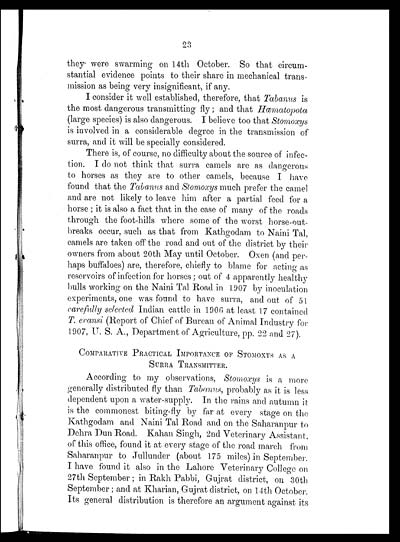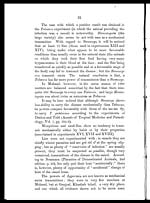Medicine - Veterinary > Civil Veterinary Departments > Indian Civil Veterinary Department memoirs > No. 2 - Collected notes
(200) Page 23
Download files
Individual page:
Thumbnail gallery: Grid view | List view

23
they were swarming on 14th October. So that circum-
stantial evidence points to their share in mechanical trans-
mission as being very insignificant, if any.
I consider it well established, therefore, that Tabanus is
the most dangerous transmitting fly; and that Hæmatopota
(large species) is also dangerous. I believe too that Stomoxys
is involved in a considerable degree in the transmission of
surra, and it will be specially considered.
There is, of course, no difficulty about the source of infec-
tion. I do not think that surra camels are as dangerous
to horses as they are to other camels, because I have
found that the Tabanus and Stomoxys much prefer the camel
and are not likely to leave him after a partial feed for a
horse ; it is also a fact that in the case of many of the roads
through the foot-hills where some of the worst horse-out-
breaks occur, such as that from Kathgodam to Naini Tal,
camels are taken off the road and out of the district by their
owners from about 20th May until October. Oxen (and per-
haps buffaloes) are, therefore, chiefly to blame for acting as
reservoirs of infection for horses ; out of 4 apparently healthy
bulls working on the Naini Tal Road in 1907 by inoculation
experiments, one was found to have surra, and out of 51
carefully selected Indian cattle in 1906 at least 17 contained
T. evansi (Report of Chief of Bureau of Animal Industry for
1907, U. S. A., Department of Agriculture, pp. 22 and 27).
COMPARATIVE PRACTICAL IMPORTANCE OF STOMOXYS AS A
SURRA TRANSMITTER.
According to my observations, Stomoxys is a more
generally distributed fly than Tabanus, probably as it is less
dependent upon a water-supply. In the rains and autumn it
is the commonest biting-fly by far at every stage on the
Kathgodam and Naini Tal Road and on the Saharanpur to
Dehra Dun Road. Kahan Singh, 2nd Veterinary Assistant,
of this office, found it at every stage of the road march from
Saharanpur to Jullunder (about 175 miles) in September.
I have found it also in the Lahore Veterinary College on
27th September; in Rakh Pabbi, Gujrat district, on 30th
September; and at Kharian, Gujrat district, on 14th October.
Its general distribution is therefore an argument against its
Set display mode to: Large image | Zoom image | Transcription
Images and transcriptions on this page, including medium image downloads, may be used under the Creative Commons Attribution 4.0 International Licence unless otherwise stated. ![]()
| India Papers > Medicine - Veterinary > Civil Veterinary Departments > Indian Civil Veterinary Department memoirs > Collected notes > (200) Page 23 |
|---|
| Permanent URL | https://digital.nls.uk/75512519 |
|---|
| Shelfmark | IP/RA.10. |
|---|---|
| Additional NLS resources: | |




